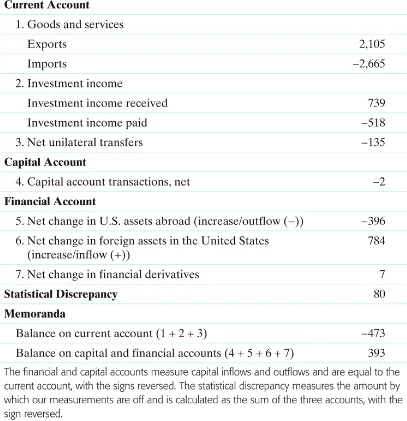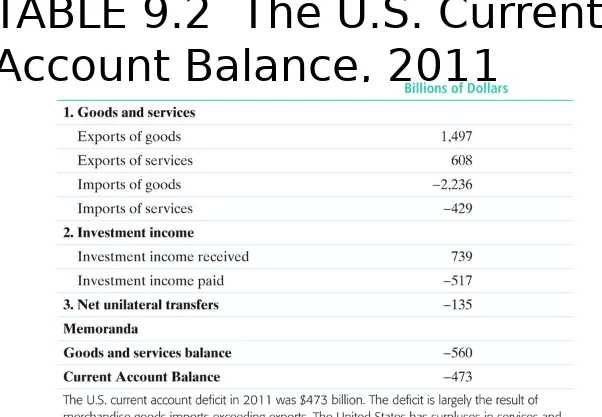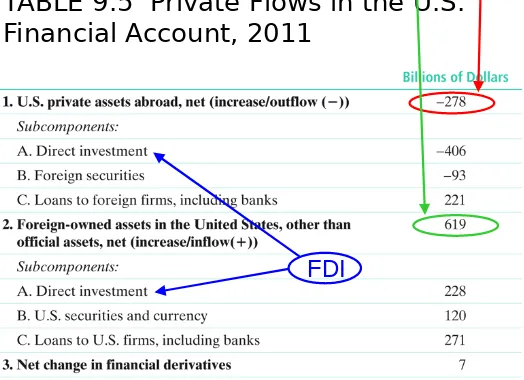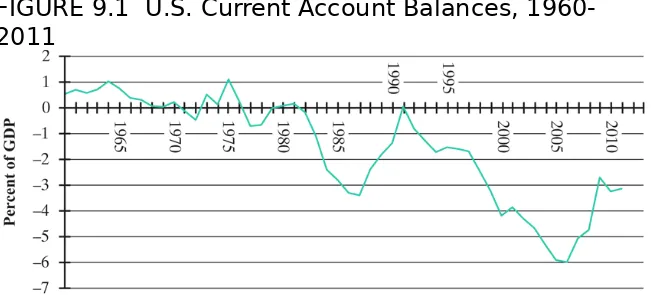12
The Balance of Trade and
International Transactions
News: Feb 17-23
•
Leaders of US, Canada, and Mexico met in Mexico,
marking the 20th anniversary of NAFTA
– Barak Obama, Stephen Harper, and Enrique Peña Nieto, the met in Toluca, Mexico, for their "Tres Amigos Summit" marking the 20th
anniversary of the North American Free Trade Agreement, NAFTA. They announced several agreements, to ease travel among the countries for people and for goods. But the meeting was a disappointment, in that Obama faces opposition at home on both trade and immigration.
– In the 20 years of NAFTA, jobs have not moved from the US and Canada to Mexico, as some feared, but neither has Mexico's income risen relative to the others, as many hoped. Intra-regional trade has grown, but not faster than trade with the rest of the world.
– Obama's trade representative, Michael Froman, argues that the negotiation of the Trans-Pacific Partnership, TPP, which includes Canada and Mexico, represents
Obama delivering on his campaign promise to "renegotiate NAFTA." Critics scoff. Econ 340, Deardorff, Lecture 12:
Trade Balance
News: Feb 17-23
•
France making changes to attract FDI
– President François Hollande met with foreign investors and
promised to limit taxes and simplify regulations, in order to make France more friendly for inflows of foreign direct investment. He also promised grants for foreign startups.
– As a socialist president, not previously very friendly to business, his time in office has been marked by a slump of inward FDI. He responded recently to rising unemployment with a "responsibility pact" that would cut labor costs and simplify labor regulations.
News: Feb 17-23
•
The US Fed issued its final rules on US
operations of foreign banks
– In the works for several years, these rules have now been weakened somewhat for foreign banks, but they are still viewed as harsh. Mainly, the Fed pushed back by one year the deadline for compliance.
– The aim is to lessen the likelihood that the US government will be asked to bail out banks when they get in trouble, including the US operations of foreign banks. To accomplish this, the Fed is requiring larger foreign banks to hold greater "capital" in their US operations, not just have access to capital held abroad.
– Though the rules on foreign banks are the same as have applied for some time to US banks, the foreign banks still complain that the rules create an "uneven playing field." Officials in Europe have said they might retaliate against US banks in Europe.
Econ 340, Deardorff, Lecture 12: Trade Balance
Outline: The Balance of Trade and
International Transactions
•
What Is the Balance of Trade?
•
What the Balance of Trade Does
Not
Mean
•
International Transactions
–
Current Account
–
Financial Account
•
What the Balance of Trade
Does
Mean
–
From Balance of Payments Accounting
Econ 340, Deardorff, Lecture 12: Trade Balance
6
What Is It?
•
Definition: Balance of Trade
= Exports minus Imports
–
Defined for
•
Merchandise (i.e., goods)
= “Balance on Merchandise Trade”
•
Merchandise plus services
= “Balance on Goods and Services”
–
“Trade Surplus” = Bal of Trade > 0
Outline: The Balance of Trade and
International Transactions
•
What Is the Balance of Trade?
•
What the Balance of Trade Does
Not
Mean
•
International Transactions
–
Current Account
–
Financial Account
•
What the Balance of Trade
Does
Mean
–
From Balance of Payments Accounting
Econ 340, Deardorff, Lecture 12: Trade Balance
8
What It Does Not Mean
•
Common Misinterpretations
–
That a deficit means we are “losing money”
•
This was sort of true when
– All money was gold (the Gold Standard), and
– There were no international capital flows
– Then imports > exports meant you were spending more gold than you were earning
•
Today there are capital flows
– A country with imports > exports can
» Borrow
•
Common Misinterpretations
–
That a deficit means we are “losing jobs”
•
It is true that
– Imports are goods we don’t produce, and
– Exports are goods we do produce
•
But whether an increase in imports means a loss
of jobs depends on why imports went up
– Often it is because more people are working, earning income, and buying more from abroad
Econ 340, Deardorff, Lecture 12: Trade Balance
10
•
Common Misinterpretations
–
That a deficit means we are “losing jobs”
•
Scott draws a direct connection from exports to
jobs gained and from imports to jobs lost
– He assumes that imports somehow replace domestic production.
– That is sometimes true, but mostly it is not
•
Griswold points out that the US economy has done
best when the trade deficit was growing!
– True, but that doesn’t mean that the trade deficit caused us to do well
– Instead, high incomes led to higher imports
•
Common Misinterpretations
–
That a deficit means other countries are
misbehaving
•
Not at all, as we’ll see.
Econ 340, Deardorff, Lecture 12: Trade Balance
12
Outline: The Balance of Trade and
International Transactions
•
What Is the Balance of Trade?
•
What the Balance of Trade Does
Not
Mean
•
International Transactions
–
Current Account
–
Financial Account
•
What the Balance of Trade
Does
Mean
–
From Balance of Payments Accounting
International Transactions
•
To understand the trade balance, it is
necessary to consider all international
transactions
–
Trade
–
Financial flows
also
–
Transfer payments, i.e. gifts
Econ 340, Deardorff, Lecture 12: Trade Balance
14
International Transactions
•
Transactions are divided into two* parts,
called
–
Current Account
–
Financial Account
*There are also two other small items, not part of these two accounts, called
– Capital Account
– Statistical Discrepancy We’ll mostly ignore these in
International Transactions
–
Current Account
•
Trade in goods
•
Trade in services
•
Investment income
•
Unilateral transfers (i.e, gifts, foreign aid)
–
Financial Account
– Includes only changes in asset holdings
•
∆
(change in) US ownership of assets abroad
Econ 340, Deardorff, Lecture 12: Trade Balance
16
International Transactions
•
All transactions are recorded as either
–
Credits (+)
•
If they correspond to payment into the country
– E.g., exports, capital inflows
or
–
Debits (−)
•
If they correspond to payment out of the country
International Transactions
•
Balances
–
Balance of Trade
= credits minus debits on trade transactions
(merchandise only, or goods and services)
–
Balance on Current Account
= credits minus debits on trade, investment
income, and transfers
–
Balance on Financial Account
TABLE 9.3 The
U.S. Balance of
Payments, 2011
• Balance of payments =
TABLE 9.5 Private Flows in the U.S.
Financial Account, 2011
FIGURE 9.1 U.S. Current Account Balances,
1960-2011
International Transactions: Data
More recently, from
Survey of Current Business
Econ 340, Deardorff, Lecture 12: Trade Balance
24
International Transactions: Data
US Export and Import Shares Since 1962
(Shaded strips are recessions)
Survey of Current Business
January 2014
$m.
Econ 340, Deardorff, Lecture 12: Trade Balance
26
Survey of Current Business
January 2014
Survey of Current Business
January 2014
Econ 340, Deardorff, Lecture 12: Trade Balance
28
Outline: The Balance of Trade and
International Transactions
•
What Is the Balance of Trade?
•
What the Balance of Trade Does
Not
Mean
•
International Transactions
–
Current Account
–
Financial Account
•
What the Balance of Trade
Does
Mean
What the Trade Balance
Does
Mean
•
From Balance of Payments Accounting
–
It must be true that credits and debits add up
to zero
•
Reason: Every transaction, if known completely,
involves two offsetting entries
– Example 1: I import a book from a London bookstore (US debit) which deposits my payment into its NY bank account (US credit)
– Example 2: Donald Trump (an American) borrows euros from a German (US credit) and exchanges them for
dollars with an Italian who has sold stock in a US corporation (US debit)
Econ 340, Deardorff, Lecture 12: Trade Balance
30
What Does the Trade Balance
Really
Mean?
•
From Balance of Payments Accounting
–
It must be true that credits and debits add up
to zero
–
Therefore (ignoring the small “capital account”
and "Statistical Discrepancy”),
Current Account Surplus
+ Financial Account Surplus
What Does the Trade Balance
Really
Mean?
•
From Balance of Payments Accounting
–
It follows that
A current account deficit
Implies
A financial account surplus
Econ 340, Deardorff, Lecture 12: Trade Balance
32
What Does the Trade Balance
Really
Mean?
•
From Balance of Payments Accounting
–
Thus, a Trade Deficit
(if it is not financed by investment income and transfers, which are also parts of the current account)
implies that we are either
•
Borrowing from foreigners, or
•
Selling assets to foreigners
Financia
l Accoun
t
What Does the Trade Balance
Really
Mean?
•
Thus the large and (until recently) growing
current account deficit of the US, which we
saw earlier, means that the US is selling
off its assets and/or borrowing from
foreigners
International Transactions: Data
Econ 340, Deardorff, Lecture 12: Trade Balance
34 From
Survey of Current Business
International Transactions: Data
From
Survey of
Current
Business
January
2014
cam
e n
Econ 340, Deardorff, Lecture 12: Trade Balance
36
What Does the Trade Balance
Really
Mean?
•
Put this in perspective
– US current account deficit reached about $700 b. per year. US population is about 300 m. So US was selling assets and/or borrowing about $2,300 per year per person.
– US net investment position is approaching $3.5 trillion. So our net debt to foreigners is over $11,000 per person.
– $3.5 trillion is a little over 1/4 of US GDP; on average we each owe about 3 months income to foreigners.
• And it’s growing.
Outline: The Balance of Trade and
International Transactions
•
What Is the Balance of Trade?
•
What the Balance of Trade Does
Not
Mean
•
International Transactions
–
Current Account
–
Financial Account
•
What the Balance of Trade
Does
Mean
–
From Balance of Payments Accounting
Econ 340, Deardorff, Lecture 12: Trade Balance
38
What Does the Trade Balance
Really
Mean?
•
From National Income Accounting
(I’ll do this first without government)
–
Recall from Econ 102
GDP = Output = Income = Y
– C = Consumption
– I = Investment
– X = Exports
– M = Imports
What Does the Trade Balance
Really
Mean?
•
From National Income Accounting
–
Thus
•
Trade surplus
⇒
savings > investment
•
Trade deficit
⇒
savings < investment
–
If we are not saving enough to finance
investment, how do we pay for it?
•
By borrowing from abroad, or
Econ 340, Deardorff, Lecture 12: Trade Balance
40
What Does the Trade Balance
Really
Mean?
•
From National Income Accounting
(This time with government)
–
Even more simply
Y = C + I + G + (X − M)
–
implies
What Does the Trade Balance
Really
Mean?
•
From National Income Accounting
X − M = Y − (C + I + G)
–
So a trade deficit
(X − M) < 0
means that we are spending
(C + I + G)
more than our income Y
Trad
e Su
rplu
s
Expe
nditu
re
Econ 340, Deardorff, Lecture 12: Trade Balance
42
What Does the Trade Balance
Really
Mean?
•
Therefore, in spite of its name, and it’s definition,
the trade balance
–
Is not really about trade, which is just the symptom
–
It is about whether we are living within our means
•
When is a trade deficit good?
–
When the country (like a young person) is investing
for the future (like a successfully developing country)
Sample Trade Surpluses & Deficits
(Exports − Imports) / GDP
2007 2012
Brazil +1.5% +0.9%
Canada –0.7%
China +8.8% +3.9%
Costa Rica −4.8% −11.9%
Germany +7.1% +7.0%
Greece −12.0% −10.3%
India −4.1% −11.1%
Japan +1.7% −0.9%
Econ 340, Deardorff, Lecture 12: Trade Balance
44
Implications of the US Trade Deficit
•
Who, in the US, is doing
this?
– Partly it has been the US government, running a deficit due to
• Tax cuts
• War
• Stimulus
– But it is also due to falling private saving
Implications of the US Trade Deficit
•
Who, abroad, is financing this?
Econ 340, Deardorff, Lecture 12: Trade Balance
46
Implications of the US Trade Deficit
•
How does US indebtedness compare to
other countries?
–
Edwards says
•
It reached 29% of GDP in 2004
•
No other large industrial country has ever done this
Sample Foreign Net Assets
(Assets − Liabilities) / GDP 2007
Brazil −39%
Costa Rica −176%
China +302%
India −6%
Japan +49%
Econ 340, Deardorff, Lecture 12: Trade Balance
48
Implications of the US Trade Deficit
•
Is the U.S. Deficit Sustainable?
–
Buffett (in 2003) says NO, as others will cease to be
willing to lend to us
–
Edwards (in 2006) assumes lending will continue, but
says dollar will depreciate by 21-28%, and cause
economic slowdown
–
Some say this is sustainable:
• This is a “balance” between US dis-saving and rest of world saving
Global Imbalances
•
This refers to
–
Large current account deficits by US and
others
together with
Global Imbalances
•
Are these a problem?
–
Many say yes
•
Imbalances are not sustainable
•
They contributed to the financial crisis
–
Others say no
•
Some say they just reflect differences in desires to
save, and that’s OK
•
Karabell says imbalances like these have
frequently existed
Econ 340, Deardorff, Lecture 12: Trade Balance
Global Imbalances
•
What can be done about them?
–
Feldstein says we need:
•
US must save more
•
China must spend more
•
Chinese currency must appreciate
Econ 340, Deardorff, Lecture 12: Trade Balance
52



